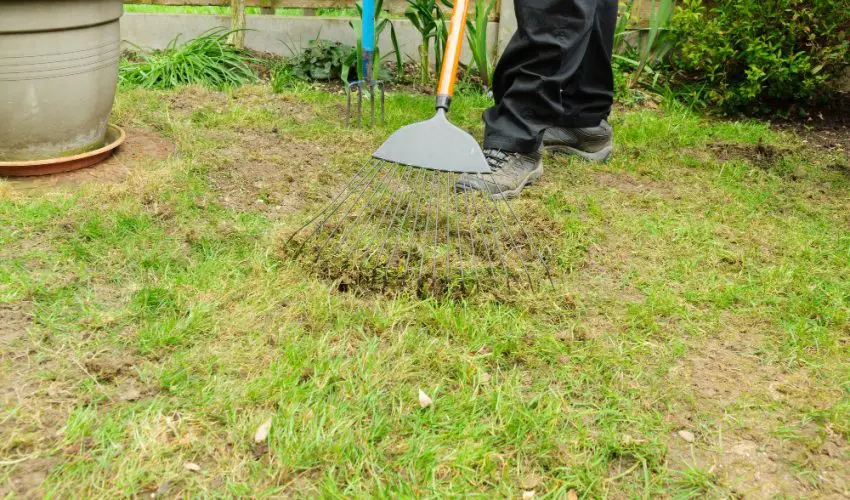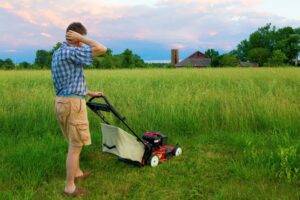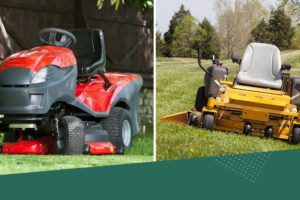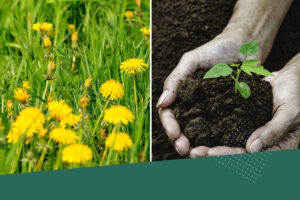Moss can be a frustrating problem for lawn owners and if it’s not dealt with fast it can quickly take over and leave your lawn looking patchy and unhealthy.
Table of Contents
ToggleFortunately, there are some things you can do to get rid of moss and prevent it from coming back.
You also need to remove the moss and apply moss killers. Make sure to re-seed bare patches with grass to prevent moss return.
What Causes Moss in Lawns?
Moss in lawns is usually a sigh of bad conditions for grass growth. These conditions can include several factors like:
1. Poor Drainage
Moss thrives in damp, poorly drained soil, and compacted soil can prevent water from draining properly. If your lawn has poor drainage or compacted soil, it can create the perfect environment for moss to grow. To prevent moss growth, it’s important to improve drainage and loosen compacted soil. This can be done by aerating your lawn, which involves poking holes in the soil to allow air, water, and nutrients to penetrate the roots of your grass.
2. Excessive Shade
Moss is also more likely to grow in areas with excessive shade. If your lawn is shaded by trees or shrubs, it can create the perfect environment for moss to grow. To prevent moss growth, it’s important to trim back any overhanging branches and thin out any shrubs that are blocking sunlight.
3. Low soil pH
Moss can thrive in acidic conditions. If the pH level of your soil is too low (meaning it’s acidic), this could be contributing to your moss problem. Grass prefers a neutral to slightly acidic soil pH, typically between 6.0 and 7.0.
4. Thatch
Thatch is a layer of dead grass and other organic matter that accumulates on the surface of your lawn. If your lawn has too much thatch, it can prevent water and nutrients from reaching the roots of your grass, creating the perfect environment for moss to grow. To prevent moss growth, it’s important to dethatch your lawn regularly.
5. Lawn Weeds
Weeds can also contribute to moss growth in your lawn. Weeds can compete with your grass for water and nutrients, creating a weakened lawn that is more susceptible to moss growth. To prevent moss growth, it’s important to keep your lawn free of weeds.
How to get Get Rid of Moss in the Lawn
It can be really frustrating to see moss in your lawn Moss can be a frustrating problem for lawn owners. Fortunately, there are a variety of methods available to get rid of moss in your lawn. This section will explore natural and chemical methods for moss control.
Natural Methods
One of the most effective ways to get rid of moss in your lawn is to address the underlying causes of moss growth. Moss thrives in damp, shady areas with poor soil drainage and low nutrient levels. To prevent moss from growing in the first place, you can take the following steps:
- Improve soil drainage by aerating the soil and adding compost or organic matter
- Increase sunlight exposure by trimming back overhanging trees and shrubs
- Adjust nutrient levels by fertilizing the lawn according to a soil test kit
- Prevent soil compaction by avoiding heavy foot traffic on the lawn
Another natural method for moss control is to rake the affected areas. Raking can help to remove dead moss and improve air circulation, which can help the grass in your lawn to grown stronger.
Chemical Methods
Chemical methods are usually the most effective ways to get rid of moss in the lawn. This includes moss killers and herbicides.
Moss killers such as ferrous ammonium sulfate, iron sulfate, and sulfate-based herbicides can be effective at killing moss. These products work by lowering the pH of the soil, which makes it less hospitable to moss.
Herbicides such as glyphosate-based herbicides can also be effective at killing moss. However, they can also harm the surrounding grass, so they should be used with caution.
Preventing Moss from Growing Back
The best way to preventing moss from growing back in your lawn is to maintaining it regularly. Make sure to remove dead grass and other debris as this allows the grass to breathe and absorb nutrients, which will help it grow stronger and healthier. Aerate the soil to allow air and water to penetrate the soil, which will help prevent compaction and improve drainage.
Draining excess water from the lawn is also important in preventing moss growth. Poor drainage can lead to waterlogged soil, which creates the perfect environment for moss to grow. If your lawn has poor drainage, consider installing a drainage system or using a top dressing to improve the soil quality.
Sunlight is essential for a healthy lawn. Shade-tolerant grasses may be a good option for areas of the lawn that receive less sunlight. Native shrubs and trees can also provide shade for the lawn, which can help prevent excessive heat and water loss.
What kills moss permanently?
The most effective ways to kill moss permanently is to use a moss killer like Scotts Turf Builder. These products are killing the moss without damaging the surrounding grass.
It’s best to use the moss killer during the winter and spring when moss actively growing.
Does dethatching get rid of moss?
Yes dethatching the lawn can help get rid of moss by improving air circulation and drainage.
However, dethatching alone may not be enough to completely eliminate moss, especially if the underlying conditions that promote moss growth are not addressed.
How to get rid of moss in a shady lawn?
To get rid of moss in a shady lawn, consider trimming back overhanging trees and shrubs to allow more sunlight to reach the lawn. You can also improve the soil drainage and aerating the lawn to improve the growth of the grass.
Conclusion
Combating moss in lawns involves understanding and addressing the conditions that favor its growth, such as poor drainage, excessive shade, and low soil pH. By improving the conditions in your lawn you can reclaim your lawn from moss and keep it healthy.





